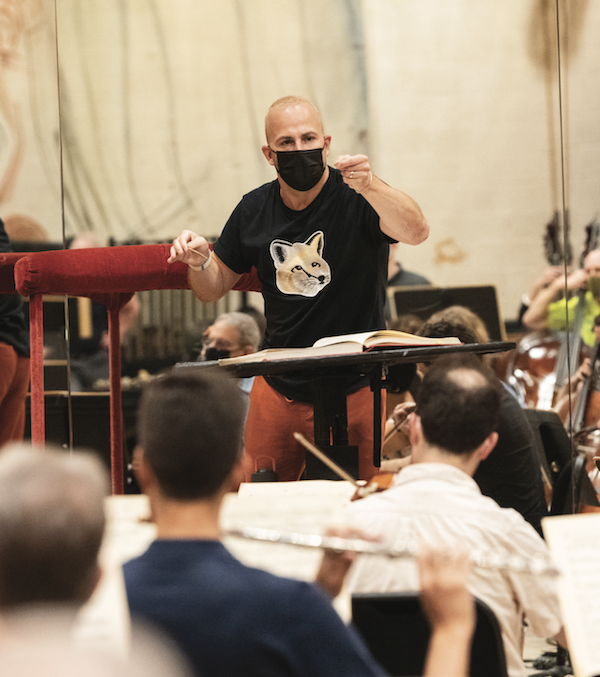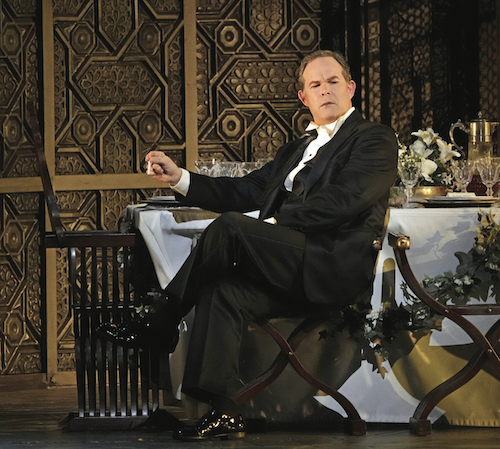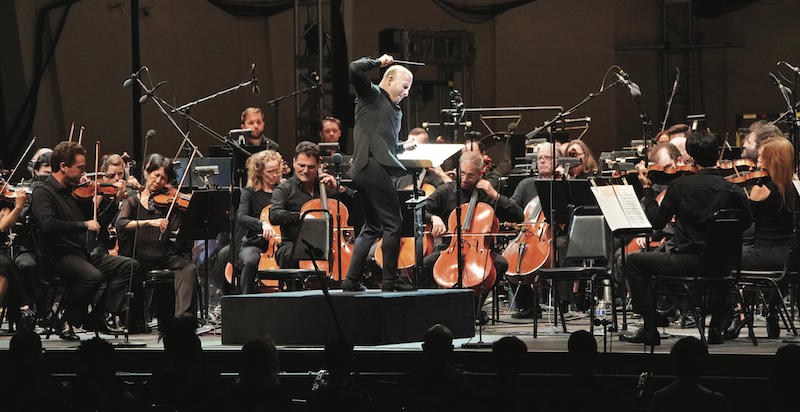New York City’s rich opera and theatre scene is back in full swing after the long pandemic silence; Patrick Dillon explores its awakening.
I HADN’T PLANNED ON THE SIXTH OF March, 2020 bearing any special significance; it was just another Friday, capped by a Flying Dutchman for which I had to write a dispirited review. Would I have enjoyed it more had I known it marked my last trip to the Met, or any other theater, for the next nineteen months? Within a week, the opera house’s doors had been shut “temporarily”—through March 31—to keep the encroaching pandemic at bay; by the nineteenth, though, the rest of the season had been canceled. By the first of June, the opening of the 2020–21 season had been postponed till New Year’s Eve; and on September 22 the season was canceled altogether. From my first taste of staged opera as a not-quite-teen, I’d never gone without one for so long a time.

Yannick Nézet-Séguin leads the Met Orchestra in a rehearsal for Terence Blanchard‘s Fire Shut Up in My Bones Ⓒ JONATHAN TICHLER / MET OPERA
When the Met finally reopened on September 27, 2021, it was with a historic splash: the company’s first-ever opera with a Black composer. I didn’t catch Fire Shut Up in My Bones till two weeks later, and my return to the Met after so protracted an absence proved more remarkable as an endurance test—Could I sit longer than three hours with a face mask uncomfortably in place? Could I keep it from clouding my opera glasses?—than as an aesthetic experience. I’d been social-distancing for so long that I felt disconcertingly close to the masked strangers surrounding me in the nearly sold-out house, whose expanses loomed vaster after the long hiatus: even from my good seat in the orchestra, the stage seemed remote—Terence Blanchard’s opera was first performed in, and certainly better served by, an auditorium a quarter the size of the Met. His Fire just didn’t blaze big enough to fill the space. Three weeks later, a splendidly cast and conducted Die Meistersinger—the season’s only Wagner—was shockingly under-attended, with barely half the 3800 seats occupied; but the opera itself filled the house in a grand-operatic way that Blanchard’s likely didn’t even aspire to. This, despite the vacancies, was the Met I remembered.
I’d missed that Met. The previous many months, of course, had offered nothing on this scale—in fact, almost everything I’d been seeing was a viewed-at-home stream, an outlet of which I’d grown exceedingly tired. The Met had presented not only a nightly stream from its video archives but pay-per-view concerts featuring many of its Covid-exiled luminaries—Lise Davidsen’s, and Sondra Radvanovsky’s in tandem with Piotr Beczała, were particular standouts.
Elsewhere, programming was equivalently makeshift. The adventurous Prototype Festival, a January fixture, radically readjusted its 2021 lineup and this year deferred what would have been its tenth-anniversary season to 2023. The regular visits from Washington DC’s Opera Lafayette didn’t happen either. New York City Opera, whose presence over the past few seasons had been sporadic, was barely missed; and the June 2021 appointment of Constantine Orbelian as its Music Director yielded little beyond its announcement.
It was the Juilliard School, shuttered along with the other Lincoln Center theaters, that offered me my first taste of live music in fifteen months with an hour’s worth of Handel’s Teseo, performed outdoors on the inhospitable premises of Damrosch Park (to the Met’s left)—amplified, but in unequal competition with a whole array of extramusical noises. I welcomed it all the same. Eight weeks later, Will Crutchfield’s admirable bel-canto-centric Teatro Nuovo presented what it billed as “the first full opera performance in New York City in over a year”—a slightly abbreviated Barber of Seville. The venue was the same noisy, uncomfortable Damrosch Park, with the same socially distanced “pods”; and clocking in at nearly three hours there was just too much of it—everyone there had seen and heard better Barbers than this one, and the nuanced virtues of a period ensemble were vitiated by the necessary evil of the park’s sound system. When the Met came back in early September, with a pair of Damrosch performances of Mahler’s “Resurrection” Symphony under Yannick Nézet-Séguin, I had no third-time’s-a-charm illusions, and stayed away.
Then, in the “big house,” came the real thing. Between that Fire and that Meistersinger, though, on the other side of town, I experienced my first recent taste of musical joy: the late-October Rossini recital of Lawrence Brownlee and Michael Spyres at the 917-seat Kaufmann Concert Hall of the 92nd Street Y. I’m a confirmed Westsider, but I couldn’t have been more elated to have made the two-bus trek and find myself amid dozens of people I hadn’t seen in ages—le tout operatic New York. The two tenors—or should I say tenor and baritenor?—seemed joyous, too, and certainly sang the virtuosic heck out of their formidable program.
Back at the Met as autumn waned, there was Matthew Aucoin’s Eurydice—a more intriguing opera than Blanchard’s, but likewise ill-served by the house’s size (both fared better as PBS telecasts). Nézet-Séguin conducted it with an often aggressive power and brilliance—an approach he applied to his very first Tosca two nights later, with only the redoubtable Radvanovsky fully able to cope. Earlier that week, on November 29, the Met announced that its multitasking Music Director would be taking a four-week sabbatical beginning at year’s end, a much-needed respite from his duties in New York and Philadelphia (site of his other American Music Directorship): “This short break,” he remarked, “will allow me to re-energize.” It also allowed him to calm down: when he returned to the Met for the new, French-language Don Carlos on February 28, he seemed wonderfully renewed, with delicacy in welcome place of the decibels that had marred his fall performances.
Meanwhile, City Opera had made one of its occasional resurfacings, with the world premiere of Ricky Ian Gordon’s Garden of the Finzi-Continis at downtown Manhattan’s Museum of Jewish Heritage. With a ho-hum score, a spotty cast, and minimal production values, it wasn’t very good; but it did demonstrate the undeniable advantages of presenting a new work in a congenial space—in this case, the 382-seat Edmond J. Safra Hall. Concurrently, uptown, the prolific Gordon’s other new opera, Intimate Apparel, got its own world premiere, in an even smaller space, Lincoln Center’s 299-seat Mitzi E. Newhouse Theatre. A better piece, it enjoyed, too, a markedly superior cast and production—the latter the work of the surprising Bartlett Sher, always in finer form apart from the Met, where his regrettable Rigoletto had recently been unveiled.
But the Met deserves a co-credit here: pairing Gordon with Pulitzer Prize winner Lynn Nottage, adapting her acclaimed 2003 play of the same name, Intimate Apparel is part of the same ambitious words-and-music partnership between the Met and Lincoln Center Theater that generated Aucoin’s Eurydice, with its text by Sarah Ruhl, likewise adapting her own play. Despite the house’s small size, there were plenty of empty seats.
Attendance at the Met remains far from capacity in 2022—the fall’s news-generating Fire was a surprising exception. The upcoming American premiere of Brett Dean’s Glyndebourne-acclaimed Hamlet, is teeming with empties, while the well-cast revival of Stravinsky’s Rake’s Progress is selling dismally. Even Glass’s Akhnaten, a major hit in 2019, is lagging this time around, though it’s one of the rare modern operas that actually thrive in a house the size of the Met. Nor is the bread-and-butter fare carrying its usual weight. The new Rigoletto and Lucia di Lammermoor, for example, were both saddled with highly flawed “concept” productions, neither of which—Sher’s transplant of Verdi’s opera to Weimar Republic Germany or Stone’s far flashier reimagining of Donizetti’s in a seedy hick town in America’s Rust Belt—had much of significance to say. Of the Met’s spring offerings, only another run of Zeffirelli’s overstuffed Turandot increased the sluggish box-office traffic.
The sure cause of that ticket-buying flutter was Anna Netrebko, scheduled to sing the title role, but the Met sent her walking papers when the Russian attack on Ukraine brought her sketchy, self-serving politics to the fore. It was a nervy move on the part of Peter Gelb, dismissing the company’s biggest draw—but Gelb’s firm response to the war in Ukraine has been beyond reproach. When the Met reopened after its planned four-week February hiatus, the Don Carlos premiere was preceded by a short, moving pre-curtain speech by Gelb and a still more moving surprise account of the Ukrainian national anthem, the chorus led by the young Ukrainian bass-baritone Vladyslav Buialskyi, a member of the Met’s Lindemann Young Artist Development Program. Two weeks later, the now familiar blue-and-yellow flag looming large above the stage, he led the anthem again, this time to open a quickly organized benefit for Ukraine, which even more rapidly had sold out—and in the process wreaked temporary havoc on the Met’s website. Nézet-Séguin had devised a program that featured Barber, Verdi, Richard Strauss (the Four Last Songs, radiantly sung by Davidsen), and Ukrainian composer Valentin Silvestrov (his haunting, a cappella “Prayer for Ukraine”) and concluded with the emotionally liberating finale from Beethoven’s Ninth, which left much of the house in tears.
The warm vibes the Met is engendering these days weren’t predictable back in September. Gelb and Nézet-Séguin had garnered few supportive cheers during the company’s shutdown and its prolonged dispute with the unions—the chorus’s, the stagehands’, and (last to reach settlement) the orchestra’s. I, not without doubts, sided with the unions. But as the season progressed, I couldn’t help admiring Gelb’s skill at getting this massive operation back on its feet and running without a significant hitch. Stringent safety protocols were enforced in all areas of the house, from backstage to the auditorium; and unlike so many European companies and Broadway shows, with their stops and starts and regular COVID-dictated casualties and closings, the Met hasn’t canceled a single performance, despite the cast changes, inevitable in even the best of times. The artistic level has been high, too. On April 21, I approached the season’s final second-cast showing of Le nozze di Figaro without much excitement: the Met is really, size-wise, no ideal Haus für Mozart (have you sensed my strong preference for smaller houses?), and Richard Eyre’s 2014 production isn’t a favourite. A conductor I’d never heard of, Nimrod David Pfeffer, was making his Met debut. But something happened very shortly into act 1: like that Brownlee/ Spyres concert, it was bringing me joy. The whole cast, starting with the reliably extraordinary Gerald Finley as the Count, was giving fully of their best; and when Federica Lombardi launched into a lush, patrician “Porgi amor” at the start of act 2, I knew that the last major player of a superb Figaro was stylishly and sumptuously in place.

Gerald Finley as Count Almaviva in Mozart‘s Le Nozze di Figaro Ⓒ KEN HOWARD / MET OPERA
Apart from the Met, with June approaching, there’s plenty to anticipate. Opera Lafayette will be back with a three-day “festival” at the 572-seat Museo del Barrio on upper Fifth Avenue. [editor’s note: read Patrick’s review here]
Crutchfield’s Teatro Nuovo will be returning mid-summer, this time in a proper theater, and with what’s hereabouts a real Rossini novelty, Maometto Secondo. Bard College’s SummerScape, up the Hudson, will be staging Die schweigsame Frau, the only Strauss opera I haven’t yet seen live; and Caramoor, a little closer to home, will offer Handel’s Theodora in concert, with Canadians Marie-Ève Munger and Tyler Duncan part of a stellar ensemble. And an invigorated Gelb—inspired by his Canadian, part-Ukrainian wife, conductor Keri-Lynn Wilson, and in conjunction with the Teatr Wielki–Polish National Opera—has organized the Ukrainian Freedom Orchestra, it’s all-Ukraiainian personnel drawn from native and other European ensembles, with Wilson on the podium for a nine-city tour of Europe, a pair of performances at the Met, and a final concert at the Kennedy Center. Among the soloists will be Ukrainian soprano Liudmyla Monastyrska, the Met’s pointed choice to replace Netrebko as Turandot. She’ll be singing, again pointedly, “Abscheulicher!”— “Monster!”—from Fidelio, and there’s scant doubt just what brutal tyrant she, and everyone hearing her, will have in mind.
*this text was originally published in the summer 2022 print version of Opera Canada magazine
Opera Canada depends on the generous contributions of its supporters to bring readers outstanding, in-depth coverage of opera in Canada and beyond. Please consider subscribing or donating today.










